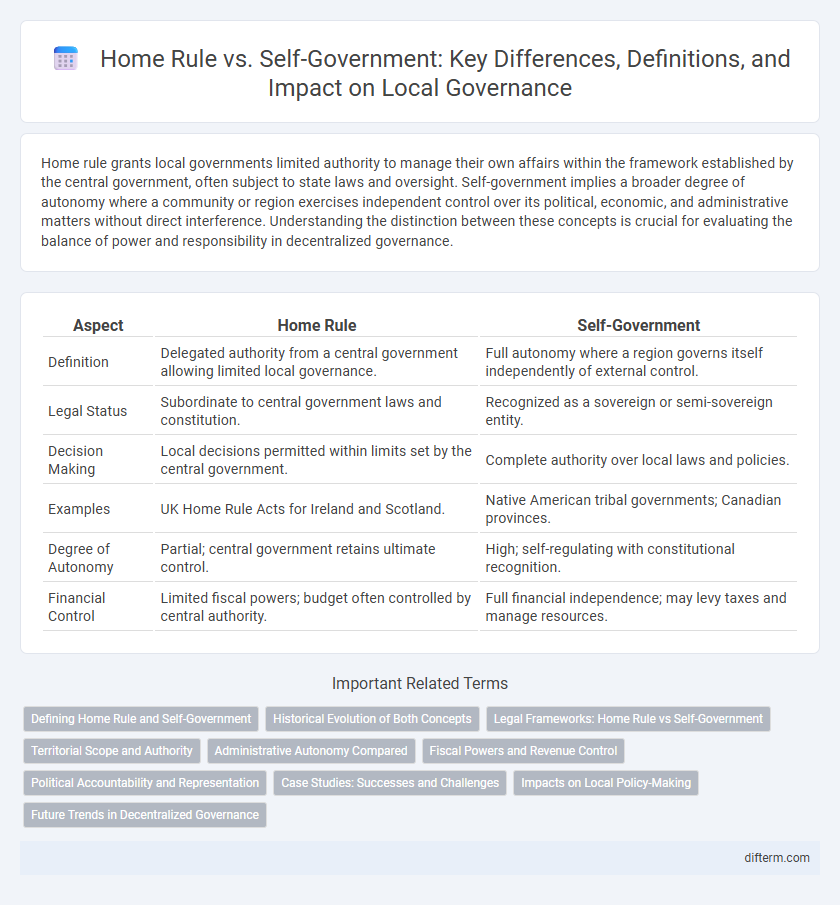Home rule grants local governments limited authority to manage their own affairs within the framework established by the central government, often subject to state laws and oversight. Self-government implies a broader degree of autonomy where a community or region exercises independent control over its political, economic, and administrative matters without direct interference. Understanding the distinction between these concepts is crucial for evaluating the balance of power and responsibility in decentralized governance.
Table of Comparison
| Aspect | Home Rule | Self-Government |
|---|---|---|
| Definition | Delegated authority from a central government allowing limited local governance. | Full autonomy where a region governs itself independently of external control. |
| Legal Status | Subordinate to central government laws and constitution. | Recognized as a sovereign or semi-sovereign entity. |
| Decision Making | Local decisions permitted within limits set by the central government. | Complete authority over local laws and policies. |
| Examples | UK Home Rule Acts for Ireland and Scotland. | Native American tribal governments; Canadian provinces. |
| Degree of Autonomy | Partial; central government retains ultimate control. | High; self-regulating with constitutional recognition. |
| Financial Control | Limited fiscal powers; budget often controlled by central authority. | Full financial independence; may levy taxes and manage resources. |
Defining Home Rule and Self-Government
Home rule refers to the authority granted by a central government to a local or regional government allowing limited legislative and administrative powers within a defined area. Self-government denotes a broader scope of autonomy where a community or region possesses substantial control over its internal affairs, including law-making, executive functions, and sometimes judiciary powers. The distinction lies in the degree of autonomy and legal recognition, with home rule often dependent on delegated powers, while self-government typically implies inherent sovereignty or constitutionally enshrined rights.
Historical Evolution of Both Concepts
Home rule emerged in the 19th century as a political movement advocating localized authority within a larger sovereign state, primarily seen in British colonies like Ireland and parts of Canada. Self-government evolved alongside, emphasizing complete autonomy and the establishment of independent governing institutions, notably in settler colonies such as New Zealand and Australia. The historical evolution of these concepts reflects a shift from limited regional powers under imperial oversight to full legislative independence and nationhood.
Legal Frameworks: Home Rule vs Self-Government
Home Rule grants local governments authority to enact laws and manage affairs within limits set by the central government, often established through enabling legislation. Self-Government provides a broader legal framework allowing communities or indigenous groups to exercise autonomous control, usually recognized through treaties or constitutional provisions. The distinction lies in the scope of legislative powers and the degree of sovereignty legally recognized under national law.
Territorial Scope and Authority
Home rule grants local governments the authority to manage affairs within a defined municipality or county, allowing limited legislative powers under state oversight. Self-government extends broader sovereignty, enabling territories or regions to exercise full legislative, administrative, and sometimes judicial powers independent of central government control. The territorial scope of home rule is typically confined to smaller jurisdictions, while self-government applies to larger territorial units, such as autonomous regions or colonies with extensive political autonomy.
Administrative Autonomy Compared
Home Rule grants a subnational government limited administrative autonomy, with significant powers retained by the central government, often including control over defense and foreign policy. Self-Government offers broader administrative autonomy, allowing subnational entities to enact laws, manage local affairs, and exercise greater fiscal independence without direct oversight. The key distinction is the degree of decision-making authority, where Self-Government embodies a higher level of decentralization compared to Home Rule.
Fiscal Powers and Revenue Control
Home Rule grants local governments limited fiscal powers, often requiring approval from higher authorities for budgetary decisions and tax levies, leading to constrained revenue control. Self-Government provides broader fiscal autonomy, enabling local entities to independently formulate budgets, impose taxes, and manage revenues without external approval. Enhanced fiscal powers under Self-Government promote sustainable economic development and tailored public service funding aligned with local priorities.
Political Accountability and Representation
Home rule grants local governments authority to govern themselves within limits set by the central government, enhancing political accountability by enabling elected officials to address community-specific issues directly. Self-government extends greater autonomy, often involving constitutional recognition, which strengthens representation by allowing communities to enact laws and policies reflecting their unique political and cultural identities. Both frameworks improve democratic participation but differ in scope and the degree of decentralized power, impacting how effectively citizens influence governance.
Case Studies: Successes and Challenges
Case studies of home rule and self-government reveal varied successes and challenges in governance autonomy, with regions like Scotland and Puerto Rico demonstrating enhanced local decision-making and cultural preservation. Successes often include improved public services and increased political engagement, while challenges arise from fiscal constraints, legal ambiguities, and tensions with central authorities. These cases highlight the complexity of balancing local autonomy with national unity, necessitating adaptable frameworks tailored to each context.
Impacts on Local Policy-Making
Home rule grants local governments authority to legislate on matters without state interference, fostering tailored policies that better address community needs. Self-government emphasizes residents' direct participation in decision-making, enhancing democratic accountability and responsiveness at the local level. Both frameworks significantly influence the autonomy and effectiveness of local policy-making by shaping the scope of local legislative power and citizen engagement.
Future Trends in Decentralized Governance
Future trends in decentralized governance emphasize increasing autonomy for local governments through enhanced home rule powers, enabling more tailored policy responses to community needs. Self-government models continue to evolve with advanced digital platforms promoting citizen participation and real-time decision-making. Emerging technologies such as blockchain and AI support transparency and accountability, driving more resilient and adaptive governance structures.
Home Rule vs Self-Government Infographic

 difterm.com
difterm.com